Introduction
- Thesis:
- Garbage and human waste is pouring into rivers and creeks are creating a pollution problem in the South Bay.
- Explanation:
- All the polluted water from sewers flows through the creeks ends up in the Bay and carries whatever trash, debris and contaminants. Humans are exposed to untreated sewage through drinking contaminated water, water recreational activities, and/or ingesting contaminated fish. (Loosli et al., 2019, p. 769).
This study highlights the issue of controlling and cleaning of the pollutions in sewage.
Water is a crucial element for all known forms of life to be able to live. Groundwater quality and availability are essential for human consumption and social and economic activities. Most of the county’s portable drinking water comes from groundwater wells, reservoirs, streams, rivers, and lakes. Unfortunately, the impact of sewage on the environment is mostly negative. Treating sewage is a big environmental priority in every country because untreated sewage water can spill into rivers, lakes and seas, causing major pollution. Such dangerous chemicals as, for example, detergent chemicals, that are contained in sewage water, are dangerous not only for the natural habitat, but for humans as well since they consume this water. Unfortunately, sanitary sewer overflows are a common problem across the United States. All the water flows through the creeks ends up in the Bay and carries whatever trash, debris and contaminants. San Jose is a troubled spot for trash pollution and bacterial pollution that are spilled into the bay. Humans are exposed to untreated sewage through drinking contaminated water, water recreational activities, and/or ingesting contaminated fish. (Loosli et al., 2019, p. 769).
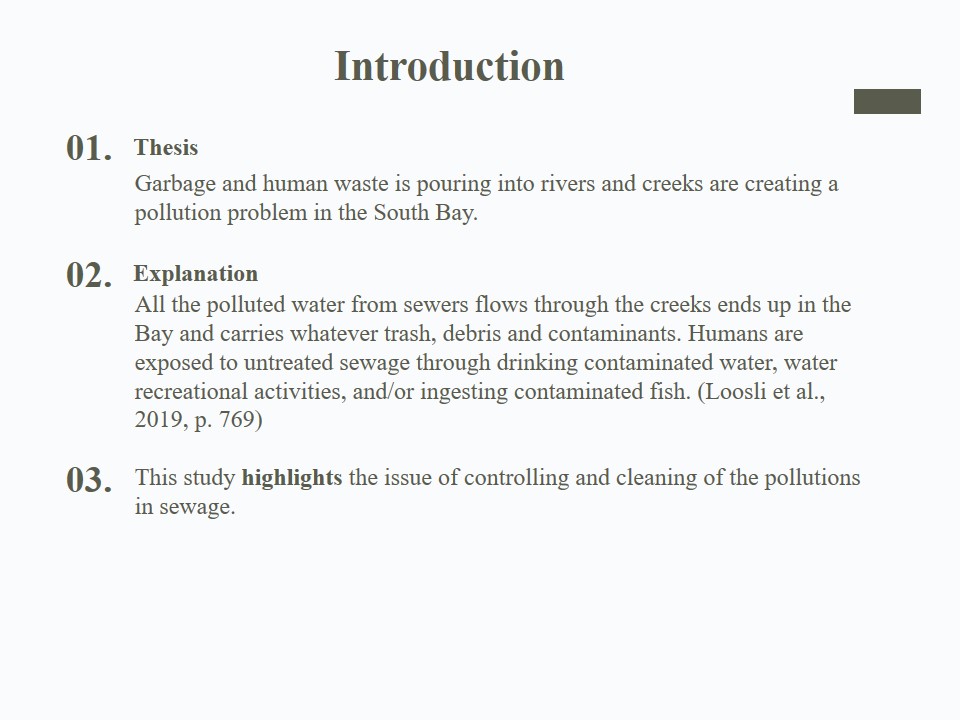
The Challenge
- Quick urbanization has enhanced the spills of of polluted sewage sludge in San Jose over the last few years.
- San Jose has more than 2,100 miles of sewage pipes.
- Considering that the sewage sludge contains toxic chemicals like nitrogen-containing compounds, organic matters and heavy metals, appropriate filtration and disposal should be utilized to prevent spills and following environmental problems (Lv et al., 2018).
- The new technology is expected to really improve the current inspection methodology by reducing the health risks for workers and making it affordable to public administrations, and also by reducing the pollution in sewage that can affect urban coastal areas.
Wastewater overflows (WWOs) are defined as a major public health issue, especially when there is a high possibility for citizens to come into direct contact with wastewater that has spilled into recreational water environments such as rivers, lakes, seas and oceans that are used for mainly recreational activities such as swimming. Infiltrated water from sewages can contain a number of pathogenic microorganisms including poisonous bacteria and viruses. Moreover, wastewater overflows have a significant effect on ecological situation of the region, creating a toxic environment for animals.

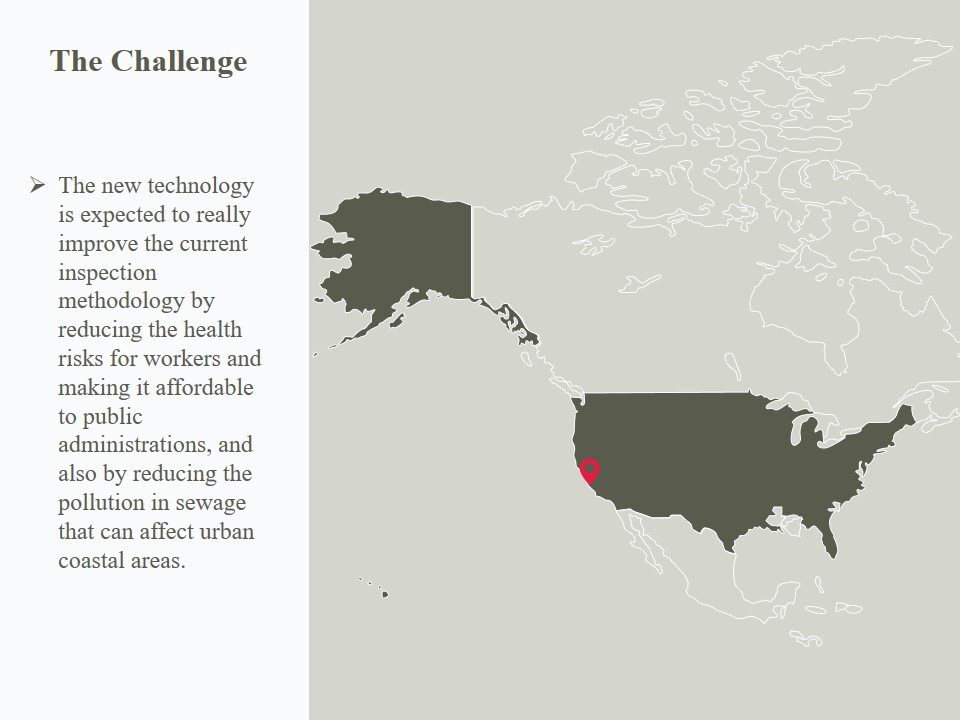
The solutions are expected to
- Improve sewer workers health and safety measures
- Improve the public service given since it optimizes the sewer cleaning resources;
- Improve the quality of life of citizens since it will improve the sewer performance.
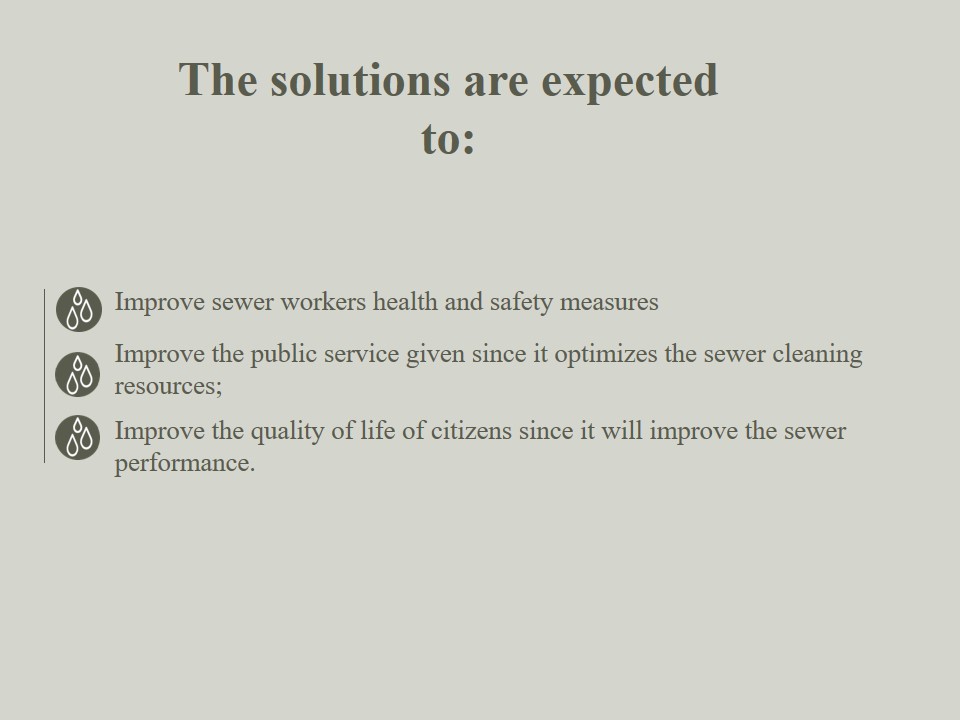
Sewer Monitoring
The goal of sewer monitoring is to develop the robot to the highest possible level of sensitivity which will let the sewer manager to manage the sewer efficiently without the need to move closer to dangerous and poisonous locations (Grau et al., 2017).
Among other reasons, robotized sewer monitoring is extremely useful:
- To keep the monitoring staff from going to sewers when there is a risky situation.
- To decide safety and health measures for staff.
- To track down any spills or leaks, which are usually unexpected and illegal,
- To make sure that sewer infrastructures are safe from abrasion, rust and aggressive spills.
- To define any patterns in sewage compounds (seasonal, daily, etc.).
- To use as an instrument for ecological investigations in sewers (David and Tobin, 2017, p. 172).
Benefits:
- Possibility to collect real-time data.
- Determining whether the system is consistently operating in free-flow conditions is easier.
- The information available from a flow-monitoring program saves collection system operators many times the cost of the flow monitoring.
- This method can be used in environmental research..
- The safety of staff is ensured as it does not require workers to go directly to sewage themselves.
Costs:
- Lack of having a set of standardization develops problems with future integration.
- It will take some time to implement the robotic solution into the working routine of the staff.
- The development of the equipment demands high financial spending.
- This method provides the means of controlling, but not preventing unexpected spills.
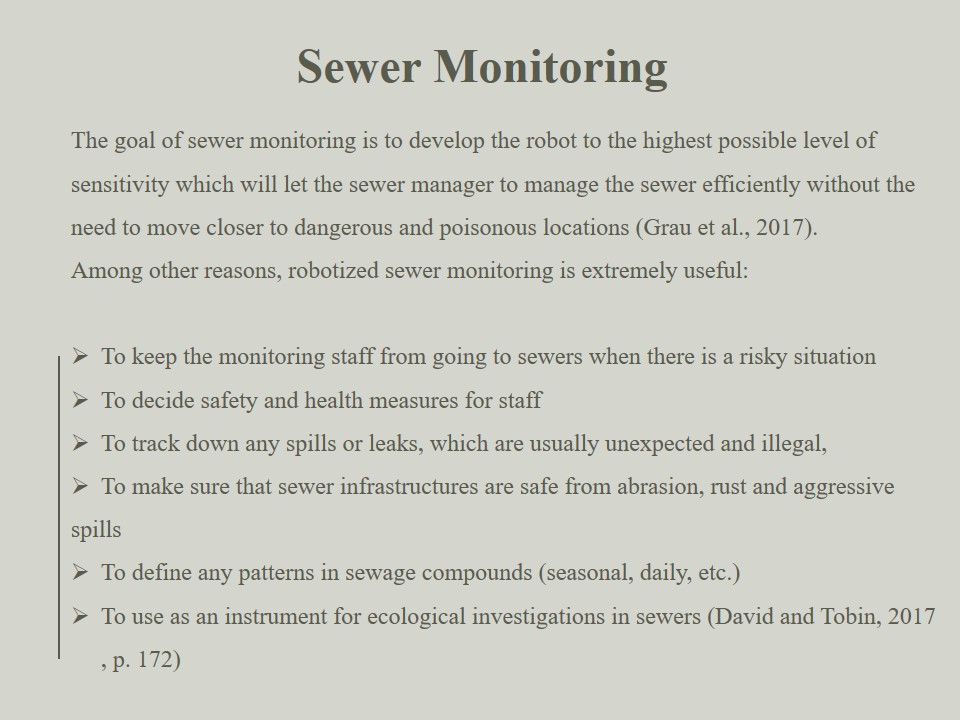
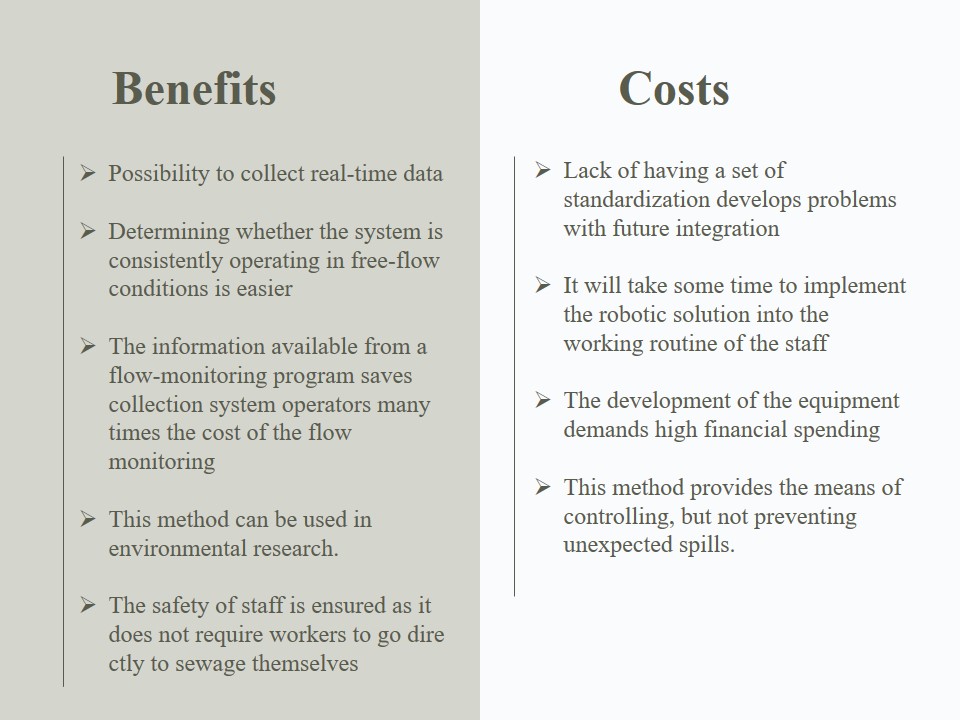
Purifying Sewage Water
This method of purifying water is complex, but effective. Every day, approximately 100 million gallons of raw sewage is treated by the Clark County Water Reclamation District (CCWRD), with roughly 90 million gallons of reclaimed water released daily into the Las Vegas Wash (Nguyen, 2019, p. 24).
The stages of purification process:
- Water from homes and businesses is flushed and streamed to nearby treatment facilities.
- Sludge is removed.
- Trash is trapper by using a mechanical rake.
- The primary treatment using rotating metal arms to skim surface scum into troughs.
- Toxic chemicals are removed through aeration process.
- Water is filtrated through sand.
Benefits:
- Energy consumption is reduced.
- Purified and filtrated water does not contain toxins.
- With clean water the habitat of South Bay is protected.
- Reclaimed water for industrial, commercial, and landscape irrigation requires less treatment than recycled water for drinking.
- Overall environmental impact is reduced.
Costs:
- The complexity of such method.
- Increased need for additional facilities and pipes to transport water.
- High financial costs for the equipment.
- Some regions still lack water recycling piping, that is why the implementing of the purifying equipment will be time-consuming.
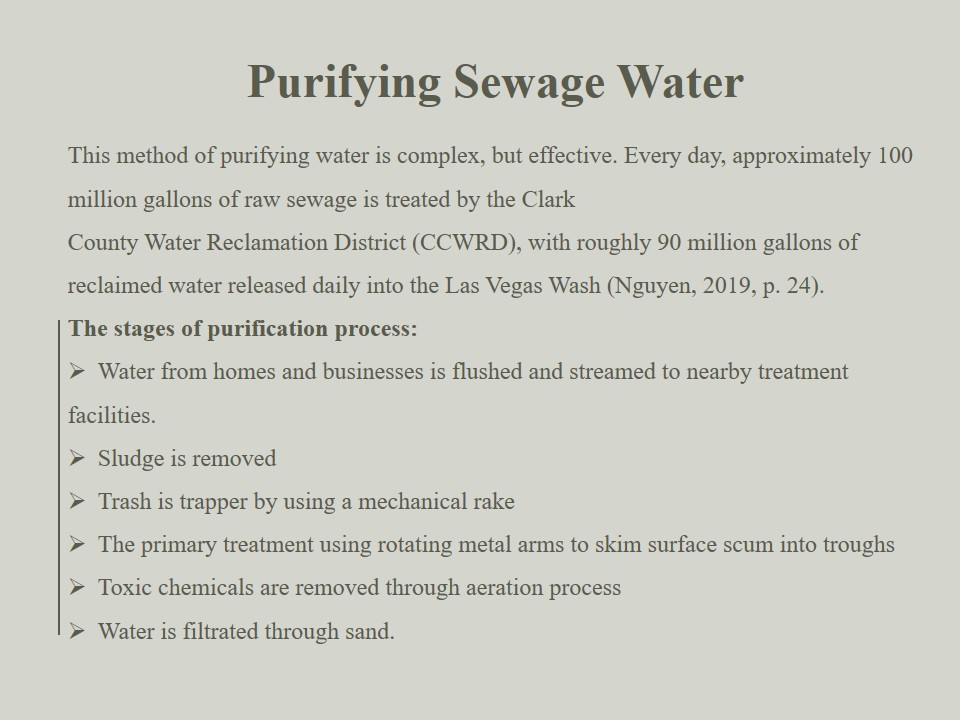

Conclusion
In recent years the problem of water sewage spills in San Jose has become more evident. The environmentalists are still trying to find efficient and low-cost solutions to the issue.
This presentation demonstrated two effective ways to control and prevent polluted water from spilling into South Bay.
Both methods that are described above have their own advantages and disadvantages.
Moreover, both methods have more benefits than costs. Nevertheless, purifying sewage water seems like a more appropriate solution since it provides quick positive results. That is why this solution is more efficient in managing sewage water as it prevents toxic spills from the start.
In conclusion it would appear that in order to maximize innovation, it’s compulsory to understand the significance of those innovations while breaking barriers in effective water management. In this case the risk of polluted spills will be greatly lowered.
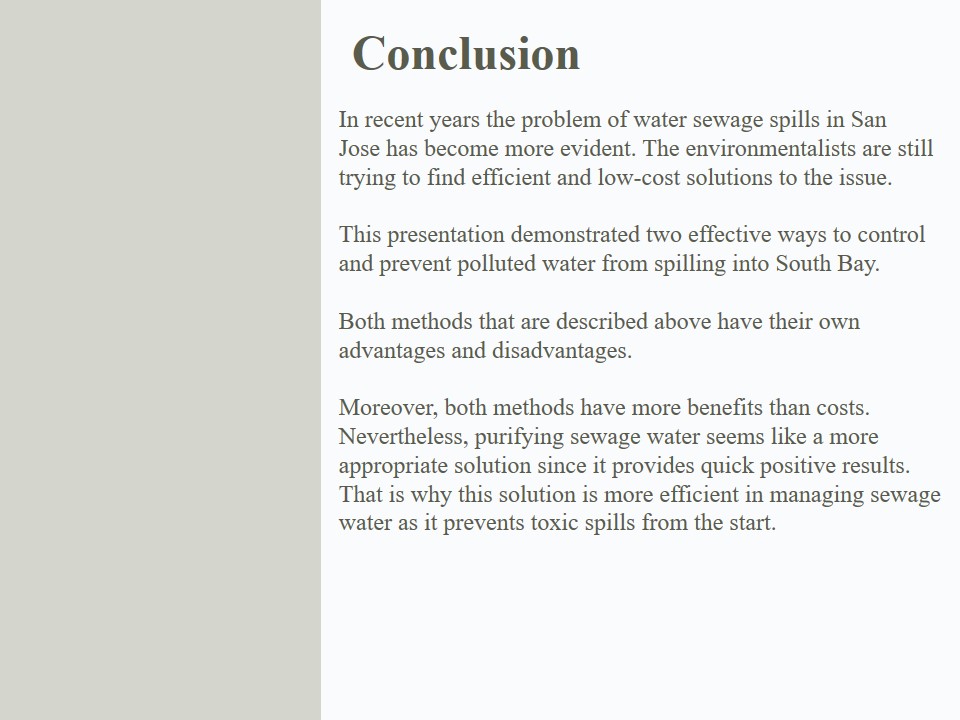
References
Grau, A., Bolea, Y., Puig-Pey, A., & Sanfeliu, A. (2017). Robotic solutions for sewage systems in coastal urban environments. Proceedings of OCEANS 2017-Aberdeen, pp. 1-5.
David, R. B., & Tobin, G. A. (2017). Understanding water policy sustainability: A case study in San Francisco and San Jose California. Environmental Science & Policy, 78, pp. 167-172.
Loosli, F., Wang, J., Rothenberg, S., Bizimis, M., Winkler, C., Borovinskaya, O., & Baalousha, M. (2019). Sewage spills are a major source of titanium dioxide engineered (nano)-particle release into the environment. Environmental Science: Nano, 6(3), pp. 763-777.
Lv, D., Zhu, T., Liu, R., Li, X., Zhao, Y., Sun, Y., & Zhao, Q. (2018). Effects of co-processing sewage sludge in the cement kiln on PAHs, heavy metals emissions and the surrounding environment. International Journal of Environmental Research and Public Health, 15(4), p. 698.
Nguyen, S. (2019). The South Bay water recycling program: an evaluation of water recycling outcomes in comparison to selected cities and countries. San Jose State University, Master’s Project.